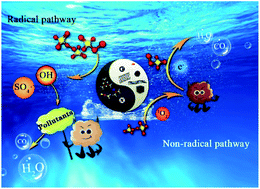Modulation of carbon induced persulfate activation by nitrogen dopants: recent advances and perspectives
Abstract
Carbonaceous functional materials are a rising star in multiple applications, such as environmental remediation, energy storage, and catalytic conversion of chemicals. Specifically, they have shown great potential for the efficient abatement of organic contaminants from the environmental medium by coupling with chemical oxidants (e.g., hydrogen peroxide, persulfates, ferrates, and periodates), where the redox nature and conductivity of carbon catalysts played significant roles. Among others, the advanced oxidation processes based on persulfates (PS-AOPs) attracted considerable attention due to their high efficiencies, low cost, and easy operation. Accordingly, PS-AOPs have been successfully applied in in situ and/or ex situ remediation of organic contaminated water and soil. Nitrogen atoms could be doped/incorporated into the carbon matrix and substitute C atoms to form different N configurations (i.e., graphitic, pyridinic, pyrrolic N), which served as the catalytically active sites for the PS activation. Through further thermal treatment, the incorporated N atoms could be transferred into the N vacancies. Additionally, the doped N atoms could further introduce the highly active single-atom sites by forming metal–N4 bonds. This paper summarized recent advances in the applications of nitrogen-doped carbon catalysts (NDCs) in PS-AOPs for the removal of organic contaminants and elucidated the underlying mechanisms. First, we briefly introduced the synthetic routes of NDCs and devoted to illustrating the relationship between the N dopants and the synthetic parameters. Second, the roles of different N configurations and N vacancies in PS activation were critically discussed based on experimental and computational evidence. Special attention was paid to the design of single-atom catalysts, and the role of metal–N4 configuration was introduced. The relationships between structure and activity were particularly focused and comprehensively discussed through statistical analysis. The influences of coexisting substances and the reusability and stability of NDCs were also taken into consideration. Finally, the current challenges and possible future perspectives were outlined based on the above discussion. Overall, this review may shed new light on the NDC induced PS-AOPs towards environmental remediation.

- This article is part of the themed collection: Journal of Materials Chemistry A Recent Review Articles


 Please wait while we load your content...
Please wait while we load your content...